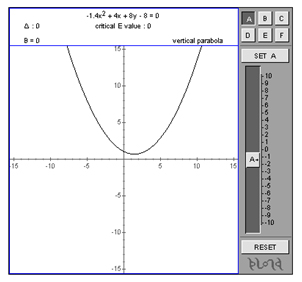Each conic section has its own equation in standard form and is a form of the general equation for conic sections. You will study those specific equations in a different lesson. The general form of the equation for conic sections is:
Ax2 + Bxy + Cy2 + Dx + Ey + F = 0
General form is the same for all of the conic sections. The values of the coefficients determine the type of conic section. For this section, we will let B = 0.
Interpreting the Parameters A and C
Below is a screen shot and link to an online applet. Click on the image to launch a new window/tab and follow the directions below. When you are done with this exercise, close the window/tab to return to this lesson.



- Use the slider to set the value for B to zero.
- Use the sliders to set the values for A and C as shown in the table below.
- In your notes, create and complete a table like the one shown below. The first one is done for you.

- After you complete your table, mouse over the table above to check your answers.
- Answer the questions below.
Summarize Your Findings
- When A·C was positive, what type of conic section was generated?
- When A·C was positive and A = C, what type of conic section was generated?
- When A·C was negative, what type of conic section was generated?
- When A·C was zero and both A and C were not zero, what type of conic section was generated?
- When A·C was zero, and both A and C were zero, what type of conic section was generated?
Generalize
For the general form equation Ax2 + Bxy + Cy2 + Dx + Ey + F = 0, and B = 0, the equation generates:
- an ellipse if
- a circle if
- a hyperbola if
- a parabola if
- a line if
- A · C > 0 and A ≠ C
- A · C > 0 and A = C
- A · C < 0
- A · C = 0 and eitherA = 0 or C = 0
- A · C = 0 and bothA = 0 and C = 0


![]()
![]()